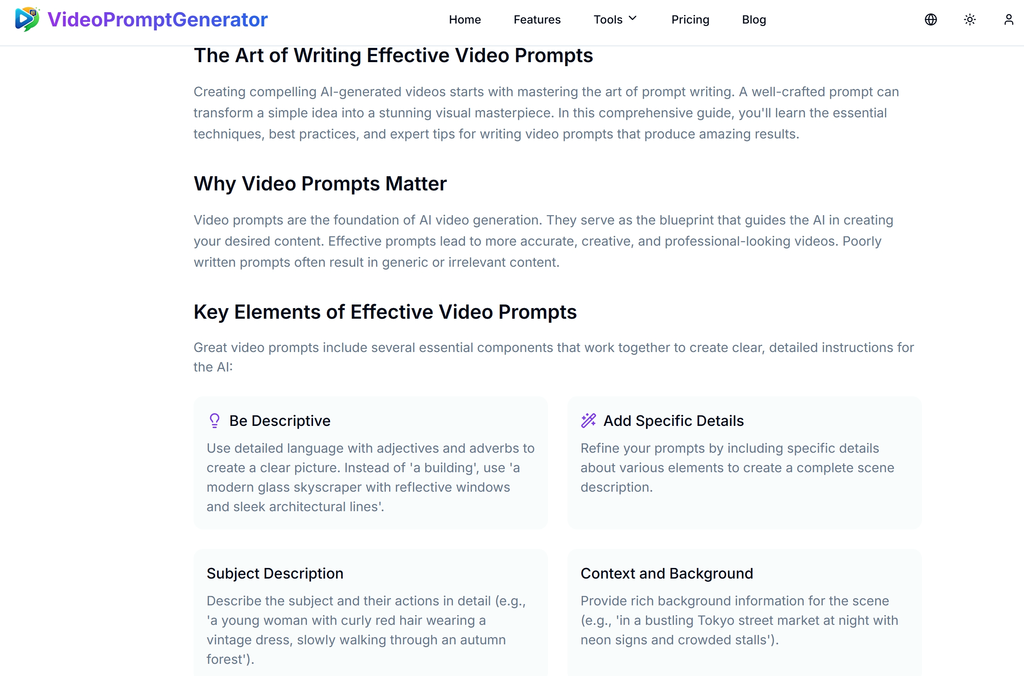Mastering Video Prompt Writing: Complete Guide to Creating Effective AI Video Prompts

The Art of Writing Effective Video Prompts
Creating compelling AI-generated videos starts with mastering the art of prompt writing. A well-crafted prompt can transform a simple idea into a stunning visual masterpiece. In this comprehensive guide, you'll learn the essential techniques, best practices, and expert tips for writing video prompts that produce amazing results.
Why Video Prompts Matter
Video prompts are the foundation of AI video generation. They serve as the blueprint that guides the AI in creating your desired content. Effective prompts lead to more accurate, creative, and professional-looking videos. Poorly written prompts often result in generic or irrelevant content.
Key Elements of Effective Video Prompts
Great video prompts include several essential components that work together to create clear, detailed instructions for the AI:
Be Descriptive
Use detailed language with adjectives and adverbs to create a clear picture. Instead of 'a building', use 'a modern glass skyscraper with reflective windows and sleek architectural lines'.
Add Specific Details
Refine your prompts by including specific details about various elements to create a complete scene description.
Subject Description
Describe the subject and their actions in detail (e.g., 'a young woman with curly red hair wearing a vintage dress, slowly walking through an autumn forest').
Context and Background
Provide rich background information for the scene (e.g., 'in a bustling Tokyo street market at night with neon signs and crowded stalls').
Action Specification
Clearly specify what the subject is doing with dynamic verbs (e.g., 'gracefully dancing', 'running at full speed', 'thoughtfully observing').
Style and Aesthetic
Add keywords for specific visual aesthetics (e.g., 'cinematic movie still', 'minimalistic design', 'surreal dreamscape', 'photorealistic quality').
Camera and Motion
Specify camera movements, angles, and perspectives (e.g., 'aerial drone view slowly descending', 'close-up tracking shot', 'Dutch angle with dramatic tilt').
Composition and Framing
Describe how the shot is framed and composed (e.g., 'wide establishing shot', 'medium close-up focusing on facial expressions', 'rule of thirds composition').
Ambiance and Mood
Use colors, lighting, and atmospheric elements to set the mood (e.g., 'warm golden hour lighting with long shadows', 'cool blue tones with misty atmosphere', 'dramatic chiaroscuro lighting').
Audio and Sound
Include details about sound effects, music, or speech when relevant (e.g., 'with gentle rain sounds and distant thunder', 'upbeat electronic music soundtrack', 'whispered voiceover narration').
Using Negative Prompts Effectively
Negative prompts help you exclude unwanted elements from your videos. Instead of using 'no' or 'don't', describe what you want to avoid:
Instead of: 'no people'
Use: 'empty street' or 'deserted landscape'
Instead of: 'don't make it blurry'
Use: 'sharp focus' or 'crisp details'
Instead of: 'no text'
Use: 'clean frame without text'
Comprehensive Prompt Examples
Here are detailed examples showing how to combine different elements into effective video prompts:
Cinematic Cityscape
A cinematic aerial drone shot of a futuristic cyberpunk city at night, with towering neon skyscrapers, flying vehicles, and rain-slick streets reflecting colorful lights. Slow panning movement from left to right, cinematic lighting with deep shadows and vibrant neon glow, 4K resolution, photorealistic quality.
Nature Documentary
A majestic bald eagle soaring over snow-capped mountain peaks at sunrise. Golden hour lighting casting long shadows, slow motion capture of wings spreading wide, cinematic wide shot showing vast mountain landscape below, documentary style with natural sound of wind and eagle calls.
Product Showcase
Sleek product reveal of a modern smartphone rotating slowly on a minimalist black background. Dynamic lighting with specular highlights dancing across the glass surface, close-up tracking shot showing premium materials and craftsmanship, professional commercial style with smooth cinematic movement.
Fantasy Scene
A mystical elf queen in an enchanted forest, wearing intricate silver armor and holding a glowing crystal staff. Magical bioluminescent plants illuminating the scene with soft blue light, fairy dust particles floating in the air, cinematic fantasy style with dreamlike atmosphere and ethereal quality.
Advanced Prompt Writing Techniques
Take your prompt writing to the next level with these professional techniques:
Layering Details
Start with the main subject, then add layers of description: environment, lighting, camera movement, and mood.
Using References
Reference specific artists, films, or styles: 'in the style of Studio Ghibli', 'cinematography like Roger Deakins', 'color palette of Wes Anderson'.
Emotional Language
Incorporate emotional descriptors: 'serene and peaceful', 'tense and dramatic', 'joyful and energetic'.
Technical Specifications
Include technical details: '8K resolution', 'slow motion 120fps', 'anamorphic lens flare', 'shallow depth of field'.
Common Mistakes to Avoid
Avoid these common pitfalls when writing video prompts:
Being too vague or generic
Use specific, descriptive language instead of general terms.
Overloading with conflicting instructions
Keep prompts focused and consistent in style and direction.
Forgetting camera and movement details
Always include camera perspective and movement instructions.
Ignoring lighting and atmosphere
Lighting dramatically affects mood - always specify it.
Best Practices for Success
Follow these guidelines to consistently create effective video prompts:
Put Your Skills into Practice with Our Tools
Now that you've learned how to write effective video prompts, try out our specialized tools to practice and refine your skills:
Image to Video Prompt Generator
Upload an image and let our AI generate video prompts based on visual content. Perfect for transforming static images into dynamic video ideas.
Start Creating Amazing Videos Today
Mastering video prompt writing is a skill that will dramatically improve your AI video generation results. By following these guidelines and practicing regularly, you'll be able to create stunning, professional-quality videos that perfectly match your vision.
Remember that prompt writing is both an art and a science. It takes practice to develop intuition for what works best, but with these techniques, you're well on your way to becoming a video prompt expert.